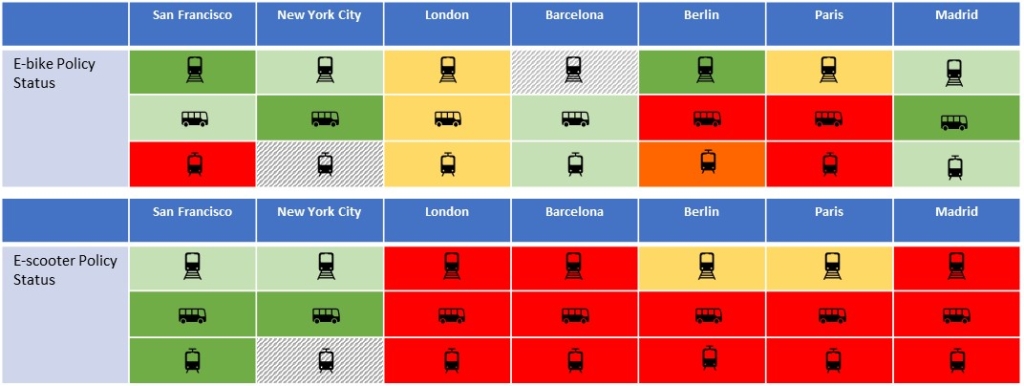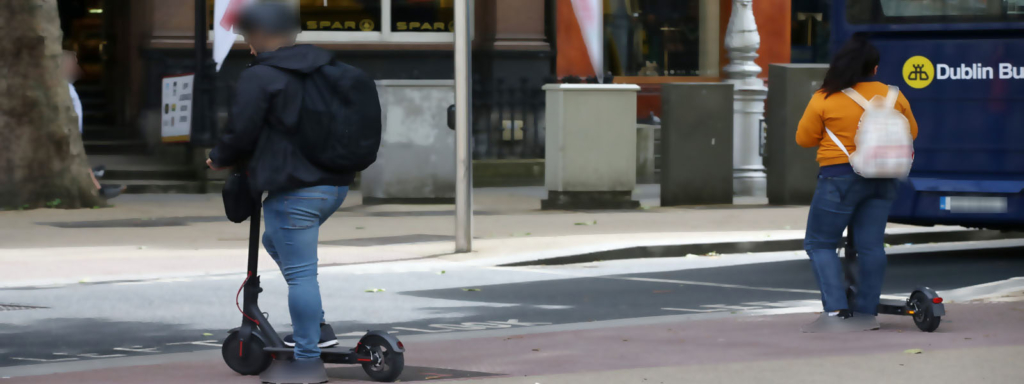The Road Traffic and Roads Act 2023, enacted in June 2023, introduced a new class of vehicle called Personal Powered Transporters (PPTs). It introduces a view to facilitating the greater use of e-scooters and other micro-mobility devices, where such devices comply with regulations made under the Act.
Under the particular legislation, there is no requirement for PPTs which comply with the prescribed standards, to be subject to registration or motor taxation and the operators of such devices are not required to have a driving license or insurance for their use on Irish roads.
The relevant legislation specifies limits on the power, weight, and maximum operational speed of PPTs.
The legalisation of the use of these types of vehicles has prompted the need to review the implication of their carriage on public transport services.
The attachment (below) is an Advice Note on the Carriage of e-Scooters on Public Transport (published in August 2024).
Guidance for e-Scooters on public transport
The Road Traffic and Roads Act 2023, enacted in June 2023, introduced a new class of vehicle called Personal Powered Transporters (PPTs), with a view to facilitating the greater use of e-scooters and other micro-mobility devices, where such devices comply with regulations made under the Act.
Under the particular legislation, there is no requirement for PPTs which comply with the prescribed standards, to be subject to registration or motor taxation and the operators of such devices are not required to have a driving license or insurance for their use on Irish roads. The relevant legislation specifies limits on the power, weight, and maximum operational speed of PPTs.
The legalisation of the use of these types of vehicles has prompted the need to review the implication of their carriage on public transport services.
As micro-mobility devices operated by electrical power become more commonplace across the world, there is considerable evidence of such vehicles posing a potential serious risk in certain circumstances. In particular, lithium-ion batteries, which are commonplace in such devices, can develop internal faults, leading to what is known as ‘thermal runaway’, whereby the battery becomes overheated leading to higher and higher temperatures and potentially resulting in the emission of toxic fumes, extreme heat, fire and potentially explosion. Lithium-ion batteries fires burn hotter – between 1000oC and 2000oC – than those involving conventional materials and are particularly difficult to extinguish.
There have been a number of such events on public transport vehicles, where lithium-ion batteries have ignited on micro-mobility devices being carried on such services. While there has been no known recorded loss of life due to such events, a number of the incidents have resulted in injuries and major amounts of damage, including complete loss of rail carriages.

Madrid, October 2023 – Rail carriage following a fire caused by an e-scooter battery.
As this is an issue impacting public transport operations around the world, various jurisdictions have developed policy positions in response. As this is an evolving area, there are varying approaches by different authorities and a singular consistent approach is not yet evident. The table below shows a snapshot of the arrangements in place in a number of cities as of June of this year (2024), with red colouring representing prohibitions.
As can be seen from the table above (International Practice), in many jurisdictions there is a differentiation between e-scooters and other electric mobility devices such as e-bikes.
This is because there is a growing level of evidence that there is a greater risk of fire or explosion of components of e-scooters when compared to other PPTs. This risk is mainly due to the following factors:
- the position of the batteries at the bottom of the e-scooter platform makes them more prone to physical damage than in the case of e-bikes where the batteries are usually positioned in a less vulnerable location; and
- the quality control of e-scooter manufacturing does not appear to be as mature and developed as e-bikes.
Overall, international experience does indicate that e-scooters represent a greater risk than other forms of PPTs in terms of incidents arising from lithium-ion batteries. In addition, until very recently, there were no technical standards for e-scooters in Ireland and there are a wide variety of e-scooters available, or already purchased, which are unlikely to meet the standards now required under new regulations.
Given their particular characteristics, there is a growing body of evidence of the fire/explosion risk associated with lithium-ion batteries on e-scooters. As the ensuring of passenger safety on public transport vehicles is a primary responsibility of transport operators, it is considered both appropriate and necessary to address this emerging risk.
Accordingly, the NTA advises that transport operators delivering public transport services under contract to the NTA, should prohibit the carriage of e-scooters, including those that can be folded or carried, from such public transport services. This guidance applies to all bus, coach, Luas, DART and other Iarnród Éireann services operated under a service contract with the NTA.
It is proposed that this restriction on bringing e-scooters onto the State provided public transport services will come into effect in early October of this year, subject to finalisation of operational arrangements and communications at individual transport operators.
It is recognised that new regulations made under the Road Traffic and Roads Act 2023 have been recently introduced, which sets out certain minimum technical standards in relation to PPTs including e-scooters. Accordingly, it is intended that the above guidance will be periodically reviewed by the NTA and the transport operators, to assess whether the introduction of the new regulations, or other developments in this area, has reduced the potential fire risk associated with these devices to the extent that would enable the introductions of e-scooters carriage on public transport.



